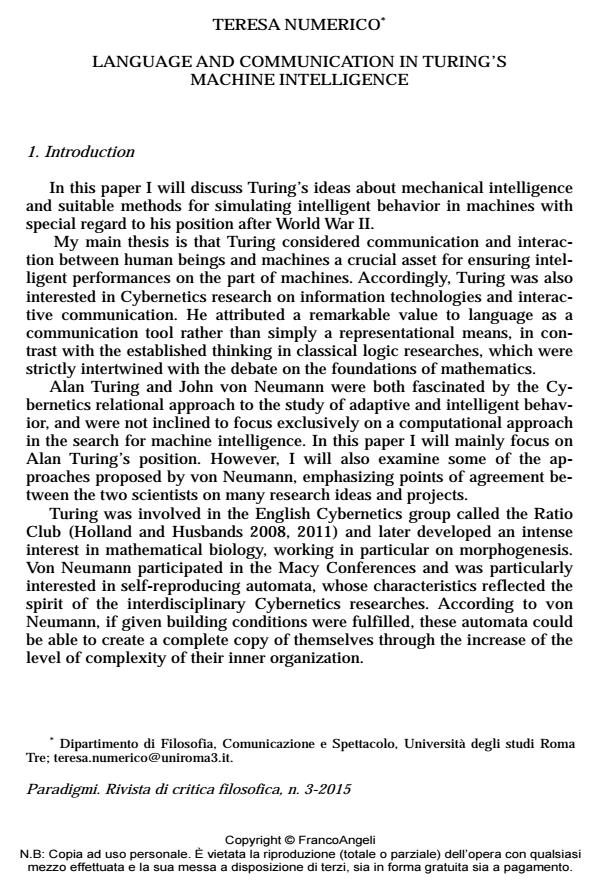Language and communication in turing’s machine intelligence
Titolo Rivista PARADIGMI
Autori/Curatori Teresa Numerico
Anno di pubblicazione 2016 Fascicolo 2015/3 Lingua Italiano
Numero pagine 19 P. 109-127 Dimensione file 76 KB
DOI 10.3280/PARA2015-003007
Il DOI è il codice a barre della proprietà intellettuale: per saperne di più
clicca qui
Qui sotto puoi vedere in anteprima la prima pagina di questo articolo.
Se questo articolo ti interessa, lo puoi acquistare (e scaricare in formato pdf) seguendo le facili indicazioni per acquistare il download credit. Acquista Download Credits per scaricare questo Articolo in formato PDF

FrancoAngeli è membro della Publishers International Linking Association, Inc (PILA)associazione indipendente e non profit per facilitare (attraverso i servizi tecnologici implementati da CrossRef.org) l’accesso degli studiosi ai contenuti digitali nelle pubblicazioni professionali e scientifiche
Il presente articolo si occupa della concezione dell’intelligenza meccanica di Alan Turing successiva alla Seconda Guerra Mondiale. La tesi principale è che Turing considerasse essenziali gli aspetti di comunicazione e interazione tra macchine ed esseri umani per ottenere dalle macchine prestazioni considerate intelligenti. L’articolo si propone di dimostrare che queste posizioni di Turing erano state influenzate dai contatti con la Cibernetica, come del resto avvenne in quegli stessi anni per John von Neumann. L’articolo inoltre interpreta il Test di Turing alla luce della centralità dell’interazione per l’attribuzione sociale di intelligenza alle macchine.;
Keywords:Alan Turing, Cibernetica, John von Neumann, Logica, Macchine intelligenti, Test di Turing.
- Copeland J. (2000). The Turing test. Minds and Machines, 10: 529-539.
- Copeland J. and Proudfoot D. (2008). Turing’s test: a philosophical and historical guide. In: Epstein G.R. and Beber G., eds. Parsing the Turing test. Amsterdam: Springer: 119-138. DOI: 10.1007/978-1-4020-6710-5
- Cordeschi R. (2002). The discovery of the artificial: behavior, mind and machines before and beyond cybernetics. Dordrecht: Kluwer. DOI: 10.1007/978-94-015-9870-5
- Cordeschi R. (2008). Steps toward the synthetic method: symbolic information processing and self organization systems in early artificial intelligence. In: Husbands P., Holland O. and Wheeler M., eds. The mechanical mind in history. Cambridge (MA): MIT Press: 219-258.
- Epstein R., Roberts G. and Beber G., eds. (2009). Parsing the Turing test. San Francisco: Springer. DOI: 10.1007/978-1-4020-6710-5
- Franchi S. and Güzeldere G., eds. (2005). Mechanical bodies, computational minds. Cambridge (MA): MIT Press. DOI: 10.1007/s00466-005-0694-1
- Gallese V. and Lakoff G. (2005). The brain concepts: the role of the sensory motor system in conceptual models. Cognitive Neuropsychology, 21: 455-479.
- Godfrey M.D., ed. (1993). The first draft report on the EDVAC by John von Neumann. Proceedings of IEEE, Annals of the History of Computing, 15, 4: 27-75
- Holland O. and Husbands P. (2008). The ratio club: a hub of British cybernetics. In: Husbands P., Holland O. and Wheeler M., eds. The mechanical mind in history. Cambridge (MA): MIT Press: 91-148.
- Holland O. and Husbands P. (2011). The origins of British cybernetics: the ratio club. Kybernetes, 40, 1-2: 110-123.
- Kline R. (2011). Cybernetics, automata studies, and the Dartmouth conference on artificial intelligence. Proceedings of IEEE, Annals of the History of Computing, 33, 4:5-16. DOI: 10.1109/MAHC.2010.44
- McCarthy J., Minsky M.L., Rochester N. and Shannon C.E. (1955). A proposal for the Dartmouth summer research project on artificial intelligence. AI magazine, 27, 4: 12-14.
- Moor J.H., ed. (2006). The Turing test. The elusive standard of artificial intelligence. Dordrecht: Kluwer.
- Numerico T. (2005.) Alan Turing e l’intelligenza meccanica. Milano: FrancoAngeli.
- Numerico T. (2010).The new machine: from logic to organization. Rutheford Journal, The New Zealand Journal for the History and Philosophy of Science and Technology, Jack Copeland: 3.
- Pias C., ed., (2003). Cybernetics. The Macy conferences 1946-1953 – Transactions. Zurich-Berlin: Diaphanes.
- Shannon C.E. and McCarthy J. (1956). Automata studies. Princeton (MA): Princeton University Press.
- Shieber S., ed. (2004). The Turing test. Verbal behavior as the hallmark of intelligence. Cambridge (MA): The MIT Press.
- Turing A.M. (1936/1937/2004). On computable numbers, with an application to the Entscheidungsproblem. Proceedings of the London Mathematical Society, Series 2, 42. (Reprinted in: Copeland J. [2004]. The essential Turing, Oxford: Clarendon Press: 58-90).
- Turing A.M. (1947/2004). Lecture to the London Mathematical Society. (Reprinted in: Copeland J. [2004]. The essential Turing. Oxford: Clarendon Press: 378-394).
- Turing A.M. (1948/2004), Intelligent machinery. Report, National Physics Laboratory. In: Meltzer B. and Michie D., eds. Machine intelligence, vol. 5, Edinburgh University Press, 1969: 3-23 (Reprinted in: Copeland J. [2004]. The essential Turing. Oxford: Clarendon Press: 410-432).
- Turing A.M. (1950/2004). Computing machinery and intelligence. Mind, 59: 433-460 (Reprinted in: Copeland J. [2004]. The essential Turing. Oxford: Clarendon Press: 441-464).
- Turing A.M. (1951/2004). Intelligent machinery, a heretical theory. (Reprinted in: Copeland J. [2004]. The essential Turing. Oxford: Clarendon Press: 472-475).
- Turing A.M. (1951a/2004). Can digital computers think? BBC program. (Reprinted in: Copeland J. [2004]. The essential Turing. Oxford: Clarendon Press: 482-486).
- Turing A.M. (1952/2004). Can automatic calculating machines be said to think? (Reprinted in: Copeland J. [2004]. The essential Turing. Oxford: Clarendon Press: 494-506).
- von Neumann J. (1947/1955). The mathematician. Works of the mind, vol 1, no 1, Chicago: University of Chicago Press: 180-196. (Reprinted in: Bródi F. and Vámos T. [1995]. The Neumann compendium. Singapore: World Scientific Publishing, pp. 618-626).
- von Neumann J. (1948/1963). General and logical theory of automata. In: Taub A.H., ed. (1963). Collected works, vol. 5, Oxford: Pergamon Press: 288-328.
- von Neumann J. (1958). The computer and the brain. New Haven: Yale University Press.
- Wiener N. (1948). Cybernetics; or, control and communication in the animal and the machine. Cambridge (MA): MIT Press.
Teresa Numerico, Language and communication in turing’s machine intelligence in "PARADIGMI" 3/2015, pp 109-127, DOI: 10.3280/PARA2015-003007